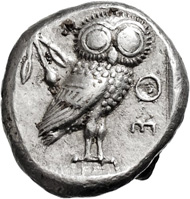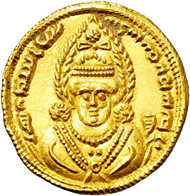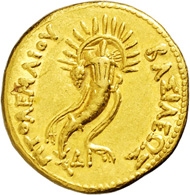11-02-2015 – 01-01-1970
Auction 306
Ancient Coins at Hirsch featuring many a rarity
On February 12, 2015, Gerhard Hirsch Nachf. will hold its ancient coin sale featuring about 1,000 lots and covering the whole spectrum of ancient coinage.
The auction begins with the Celtic Coinage among them an almost uncirculated rainbow cup from southern Germany, estimated at EUR 5,000.-.
Attika. Athens. Tetradrachm. 510-480 BC.
The Greek Coins are up for auction next, among them a Tetradrachm struck in Syracuse (474-ca. 450 BC) showing the head of the nymph Arethusa. This piece is estimated at EUR 6,250.-. From the Greek motherland a Tetradrachm from Olynthos, which was the capital of the Chalkadian league in the 5th/4th Century BC comes under the hammer next. This uncirculated Tetradrachm with the head of Apollo will be auctioned at EUR 5,000.-. Among the coinages from Athens, an early Tetradrachm displaying the head of Athena is especially noteworthy. This type of coinage was introduced around 510 BC by the sons of Peisistratos and is estimated at EUR 9,500.-. Especially interesting is an unpublished 1/6 electrum stater from Asia, stemming from the first half of the 6th Century. This coin with protomen of a stag is estimated at EUR 3.000.-.
1958: Sassanid. Khusru II. 590-627 AD. 1 1/2 Gold Dinar.
Among the coinage of the Lycian dynasty is a stater of Mithrapata (390-370 BC), the hereditary ruler of Antiphellos, with the protomen of a lion, estimated at EUR 4,750.-. The great king is shown in the title piece of the auction: a golden double daric from Persia, struck in the time of Alexander the Great (333-323 BC, estimated at EUR 6,500.-). In almost uncirculated condition, a 1 1/2 gold dinar of Khusru II (590-627 AD) from the Sassanid empire is estimated at EUR 7,500.-.
1984: Egypt. Ptolemaios IV. Philopatoros. 221-204 BC. Gold Oktodrachm.
Among the coinage of Egypt, a gold oktodrachm of Ptolemy IV Philopatros (221-204 BC) is noteworthy. It shows the deified father – Ptolemy II with a radiant diadem – is estimated at EUR 15,000.-. A shekel from Carthage during the time of the Libyan rebellion (241-238 BC) displaying the ethnicon of the Libyans on the reverse is in extremely fine condition and will go under the hammer with a valuation of EUR 7,000.-.
Imperial Rome. Hadrianus. 117-138 AD. Aureus.
Next the Roman Coins, beginning with the coinages of the Roman Republic (35 Lots) among these a very rare Denarius of Lucius Aemilius Buca from the year 44 BC is of note. It shows Sulla and the moon goddess Luna and, in its extremely fine condition, is to go under the hammer for EUR 5,000.-. Subsequently, a small series of selected coins from the Civil War Period goes under the hammer. A denarius showing the veiled head of Marcus Antonius, also from the year 44 BC, is estimated at EUR 3,100.-.
Next are the Roman Imperial Coinages, which begin with an aureus of Augustus (27 BC-14 AD) struck in Lugdunum (today Lyon) displaying Apollo, the patron god of the emperor (Estimate EUR 5,250.-). An aureus of Nero, struck under the reign of Claudius (54-69 AD), shows Nero being admitted to the priests of Rome and is estimated at EUR 7,000.-. Shown on an aureus of Hadrian (117-138 AD) are the twins Romulus and Remus with the Roman wolf and will go under the hammer with a valuation of EUR 8,800.-. Among the bronze coinage is a sestertius of Antonius Pius (138-161 AD) of particular note. This coin shows the river god Tiber and is estimated at EUR 11,000.-. A Denarius of Pescennius Niger, crowned emperor in the year 193 AD but lost a decisive battle for supremacy the following year and was executed, is an especially rare piece coming under the hammer with a valuation of 2,250.-. Also very rare is an aureus of Julia Domna, the wife of Septimus Severus (193-211 AD). This coin shows the camped earth goddess Tellus and will be auctioned for EUR 7,000.-. An aureus of Gordianus III (238-244 AD) with an image of a standing Jupiter is estimated at EUR 8,000.-. Probably unpublished is a hacked piece of a 6 Aurei gold medallion of Gallienus (253-268 AD) estimated at EUR 8,000.-.
2319: Imperial Rome. Julianus of Pannonia. 284-285 AD. Aureus.
Another piece of exceptional rarity is an aureus of Julianus of Pannonia (284-285 AD). He was proclaimed emperor by his troops, after which he advanced on Rome, until he was defeated near Verona by Carinus. This extremely fine to uncirculated coin is being estimated at EUR 45,000.-. A miliarens of Valens (364-378 AD), struck in Trier, is of extremely fine quality and goes under the hammer at EUR 6,000.-. Noteworthy are also the only two known gold plated strips with the imprint of the reverse of a centenionalis of the mint at Cyticus from the time of Procopius (365-366 AD). These will go under the hammer at EUR 3.000.- and EUR 1,500.- respectively. An almost uncirculated solidus of Anthemius (467-472 AD) show Leo I and will be auctioned at EUR 10,000.-.
From an interesting series of Byzantine Coins, a solidus of Michael III and his mother Theodora (842-856 AD) with a valuation of EUR 3,500.- presents a noteworthy piece. A solidus of the utmost rarity from the time of the barbaric invasions, presumably struck under the eastern Goths in the name of Justinianus I in Ticinium, comes under the hammer with EUR 2,000.-. At the end of the ancient coins, 80 multiple lots goes under the hammer.
All antique art objects you may find on the website of Gerhard Hirsch Nachfolger.














